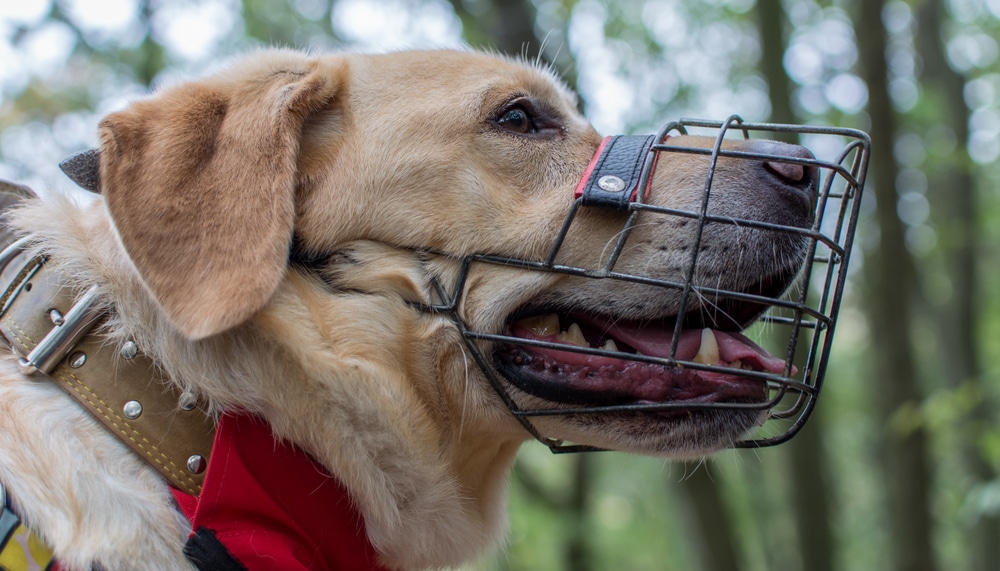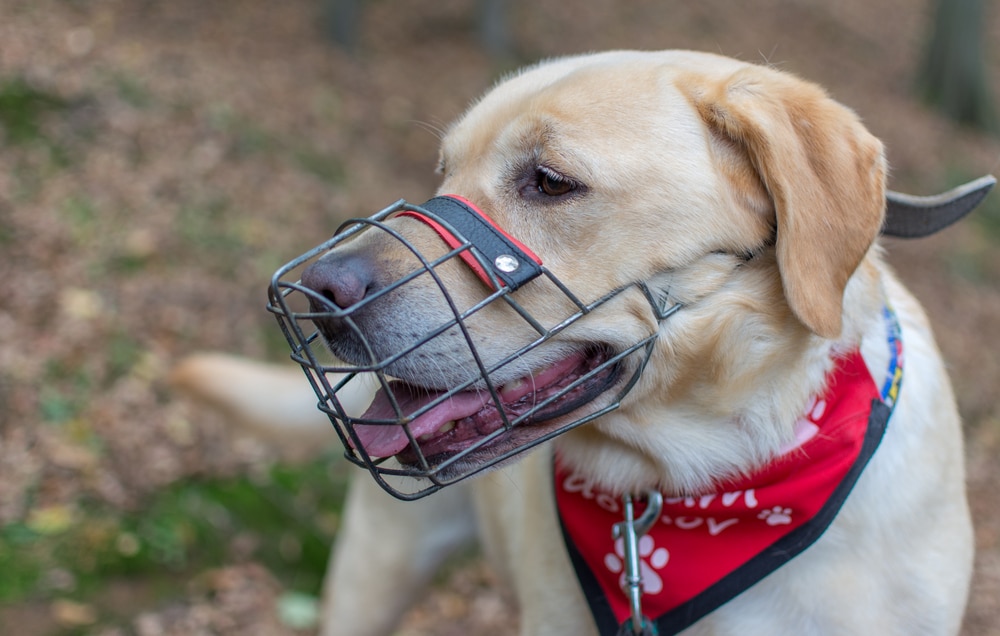Muzzles are sometimes unavoidable, but our furry friends seem to hate them! If muzzling makes our pets so uncomfortable, is it also true that muzzles are inhumane?
When used correctly, muzzles are a great tool to keep your dog and others around them safe from harm. When muzzling your dog becomes necessary, choosing the right muzzle to suit your purpose is important. If owners and trainers use them appropriately, muzzles are not inhumane.
Table of Contents
What Are Muzzles?

Muzzles are coverings used over the jaws and snout of a dog to prevent them from eating, chewing, or biting by limiting the use of their mouth.
Previously, the use of muzzles has been heavily stigmatized *and considered inhumane) because of the idea that wearing a muzzle is restrictive. However, a well-fitting muzzle with a design appropriate for the purpose that it is being used is not dangerous or uncomfortable for your dog. In fact, they make it possible for us to safely interact with unpredictable dogs and provide them with better training and rehabilitation.
Another reason pet parents might hesitate to use a muzzle is its association with aggressive or “bad” dogs. In mainstream media, a muzzle is often used to imply that the dog is fearsome and prone to biting, making owners feel that their friendly pup will never need one. But muzzles have various useful indications such as stopping your dog from eating or chewing things they aren’t supposed to. This makes them just as important in keeping your dog safe as they are in protecting others around them.
Different Types Of Muzzles
Thanks to their growing popularity amongst behaviorists that use positive reinforcement to train dogs, a wide range of different types of muzzles are now available (and considered less inhumane). Choosing the correct muzzle to suit your purpose will provide maximum functionality without compromising your dog’s comfort. While there are huge variations in the different materials, structures, and styles of modem muzzles, the major types of muzzles are the following ones.
Grooming/Tube Muzzles
These are the traditional style of muzzle and arguably, part of the reason why muzzles get a bad reputation. Tube muzzles fit snugly over your dog’s closed snout and are tightened behind the ears by a string or clasp. These are great for quick procedures such as grooming, nail trims, or getting a jab at the vet, and they fit compactly into a pouch or bag to store for use in an emergency while traveling.
But tube muzzles aren’t totally bite-proof. Your dog can still nip through the front of the muzzle unless it’s really tight around the mouth.
Closing the mouth so tight also prevents your dog from opening its mouth to pant. Dogs regulate their body temperature by panting. So, forcing their mouth closed for long periods of time can cause them to overheat. So, heatstroke can be a fatal consequence of using a tube muzzle for prolonged periods.
Remember to only use these muzzles for a few minutes at a time. If your dog needs to be muzzled at home to prevent nuisance chewing or before getting into the car to go to the vet, this isn’t the right type of muzzle to use.
Strap Muzzles
Strap muzzles consist of a simple nylon strap that wraps around your dog’s snout to keep it closed, usually as part of a halter or head collar. Although easy to put on, these aren’t very reliable. This is because they can easily slip off or snap, especially on short-nosed breeds. The only way to secure them is to tighten them, which may crush your dog’s jowls, causing pain. Additionally, they also do not allow your dog to pant, putting them at risk of overheating.
Basket Muzzles
Putting on a basket muzzle essentially puts your dog’s snout into a cage of sorts. Within the cage, your dog can use its nose and mouth as it normally would. When properly fitted, basket muzzles allow your dog to pant, drink, and even eat small treats while protecting the handler and others around from unexpected bites.
Because they allow your dog to pant, these muzzles are great for dogs that need to wear a muzzle for long periods, such as when they are alone at home, during car rides, or during training. Being able to feed your dog treats while they are still wearing the muzzle makes training more efficient. It also helps the dog accept the muzzle much faster.
Muzzles aren’t one-size-fits-all though. Basket muzzles have been designed in a wide variety of styles and materials that vary in their bite-proofing, ventilation, cleanability, style, and durability, all of which suit different purposes. For example, a leather muzzle reinforced with steel may be unsuitable for a pomeranian. Also, a Cane Corso would make quick work of a cheap plastic or silicone muzzle. Understanding the intended purpose of the muzzle before you buy it will help narrow down the options available. You may even consider getting more than one type of muzzle for your dog. This would especially be a good idea if you know they will be wearing it regularly in different situations.
Do All Dogs Need A Muzzle?
The primary purpose of a muzzle is usually to restrain your dog from using its mouth in undesirable ways. This includes biting, or as a short-term solution for unwanted chewing, eating, or licking.
Also, in some states, the law requires that certain breeds wear a muzzle at all times when they are out in public. Of course, not all dogs fall into these categories. If your dog has no legal obligation to wear a muzzle, has a great temperament, and never sticks its nose into things it isn’t supposed to, you may never have a reason to put a muzzle on.
But dog behaviorists always recommend training your dog to accept a muzzle at an early age before the need for one ever arises. Puppies are much more tolerant than adults of new experiences such as when an owner places a muzzle on them.
So, introducing them to the sensation of a muzzle when they are young will prevent the fear and aversion that is common in older dogs. Even the best dogs get nervous in stressful situations such as going to the vet or groomer. Especially if they have an unpleasant experience such as being injured during a nail trim, they may become fear-biters. In this situation, training or hiring someone to train your dog to accept a muzzle will save you a lot of time and effort.
How To Train Your Dog To Accept A Muzzle
In order to create a fear-free experience for your dog, owners must introduce muzzles slowly. This means gradual training over a period of time, long before your dog needs to wear it for any specific purpose.
Initial Steps
So, introduce your new muzzle slowly. Allow your dog to approach and investigate it on its own terms. Feed your dog treats and give lots of praise. When it seems like your dog is okay with having the muzzle in front of its face, try and place it gently on top of its snout. Pet your dog and give it treats as you do this. Immediately stop if you see it shying away, and try again the next day.
Next Steps
Next, hold the muzzle in front of your dog’s face as you would if you were about to put it on. Place some treats on the inside of the muzzle. Doing this will encourage your dog to reach in to get them. Don’t make any jerky movements or try to force the muzzle onto your dog’s face at this point as that can create fear and aversion. It is much harder to overcome a negative experience than it is to create a novel positive one.
Final Steps
The next day repeat again with the treats. When your dog is placing its whole face into the muzzle on its own, gently slip the muzzle on all the way for a few seconds and take it off. Immediately praise and treat.
Gradually increase the time you leave the muzzle on your dog. Using a basket muzzle is extra beneficial at this time because you can give your dog treats through the holes in the basket.
When your dog is ready, fasten the muzzle. Continue to treat and pet your dog as long as it remains calm. If your dog starts to paw at the muzzle, do not reward it by doing what it wants and taking it off. Only remove the muzzle when it is calm. Continue to offer treats when your dog puts on its muzzle, even when the training period is over.
What Are The Risks Of Muzzles?
Muzzles used incorrectly can have unpleasant and even fatal consequences. Tube or strap muzzles and even some types of basket muzzles that limit ventilation must never be used for prolonged periods of time. This is because your dog won’t be able to expel their body heat by panting, making them susceptible to overheating.
Using a muzzle to stop nuisance behaviors like chewing and biting is somewhat effective in the short term. But these behavioral issues can and need to be corrected with training. Sometimes, these are also a sign of underlying problems. For example, unwanted chewing or eating may indicate dental issues or nutritional problems that require immediate attention. Slapping on a muzzle will not solve the issue and may put your dog’s health at risk.
Also, no one should allow a dog to wear a muzzle unsupervised. They are amazingly capable of slipping out of even the best-fitting muzzle, putting themselves or others at risk while you’re not around to help. They may even injure themselves while trying to take it off. For example, eye injuries are common in dogs pawing at their face while trying to remove a muzzle.
In Conclusion: Are Muzzles Inhumane?
Muzzles are excellent tools to protect your dog and others around it. They allow owners to handle dogs safely in stressful situations, and owners can use them to train and rehabilitate dogs with behavioral issues.
With the correct research and training, modern muzzles are not inhumane. On the contrary, they actually allow us to avoid unnecessary injury to ourselves, protect our dogs from themselves, and safely give problem animals a second chance.
However, prior to starting muzzle training with your dog, we always recommend consulting with your veterinarian.
So, what do you think about muzzle training and whether or not muzzles are inhumane now? Let us know your thoughts and why in the comments below!
